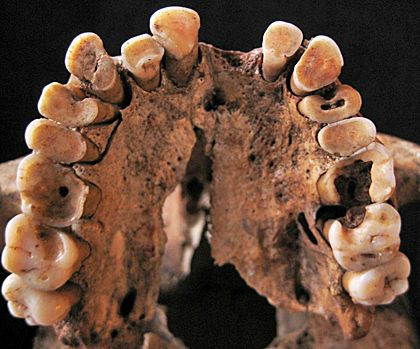Prehistoric Moroccan Teeth Discovered, Fossils Prove Stone Age Hunters Had 'Rotten' Oral Health

A new study of Stone Age human teeth proves that even our ancestors defied dentists’ orders. Archaeologists studying 13,700-year-old teeth recovered from Morocco’s Grotte des Pigeons found some of the earliest evidence for common tooth decay, suggesting that dental caries were widespread much earlier than scientists previously thought.
Tooth decay in humans is commonly associated with the rise of agriculture during the Holocene period, around 12,000 years ago, which provided carbohydrate and sugar-heavy diets. The Agricultural Revolution ushered in a new era of processing wheat and barley into sugar-rich foods like bread and porridge, which wreaked havoc on peoples’ mouths. But this new research suggests that humans suffered tooth decay thousands of years before then.
“This is the first time we've seen such bad oral health in a pre-agricultural population,” the study's co-author Isabelle De Groote said in a statement. “These people's mouths were often affected by both cavities in the teeth and abscesses, and they would have suffered from frequent toothache.”
De Groote and her team from the Natural History Museum in London analyzed the remains of 52 Stone Age adults buried in the Moroccan cave between 15,000 and 13,700 years ago. Archaeologists found evidence of tooth decay in half of the surviving teeth. Only three of the skeletons studies at Grotte des Pigeons lacked cavities.
That rate of tooth decay was comparable to that of modern societies with diets chock-full of refined sugars.
So if Stone Age Moroccans had yet to cultivate crops, what were they eating that led them to suffer such severe tooth decay? According to the study, published in the journal PNAS, the early North Africans probably harvested and processed edible wild plants, including acorns and pine nuts. “We infer that increased reliance on wild plants rich in fermentable carbohydrates and changes in food processing caused an early shift toward a disease-associated oral microbiota in this population,” the authors noted.
“A heavy reliance on certain plant foods well before people started to rely on cultivated plants could, in certain circumstances, lead to significant [tooth decay] levels,” the University of Leicester’s Marijke van der Veen told New Scientist.
The acorns were probably boiled or ground to make flower, the scientists said. Cooking the nuts would have made them sticky and added abrasive particles from the grindstone to the mix, which would have caused the teeth to wear down. Eventually, cavities would have formed.
"At a certain point, the tooth nerve dies but up until that moment, the pain is very bad and if you get an abscess the pain is excruciating because of the pressure on the jaw," Louise Humphrey, co-author of the study, told the BBC. "Then, of course, the bone eventually perforates and the abscess drains away, and we see this in a lot of the jaw remains that we studied."
© Copyright IBTimes 2024. All rights reserved.






















